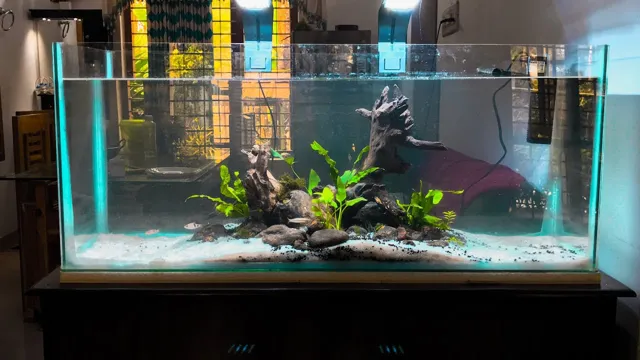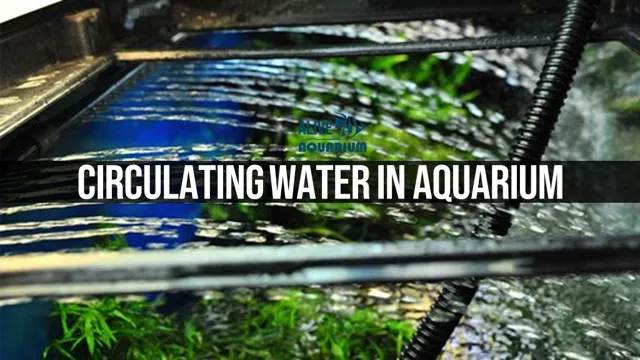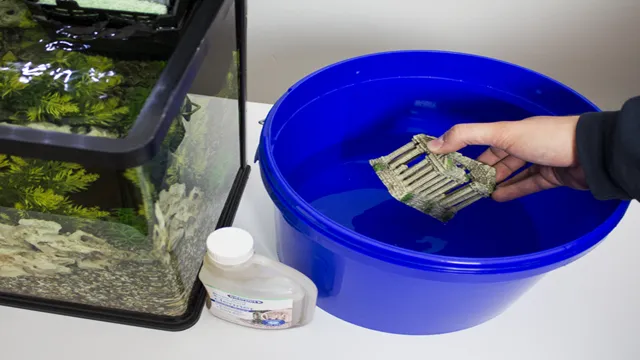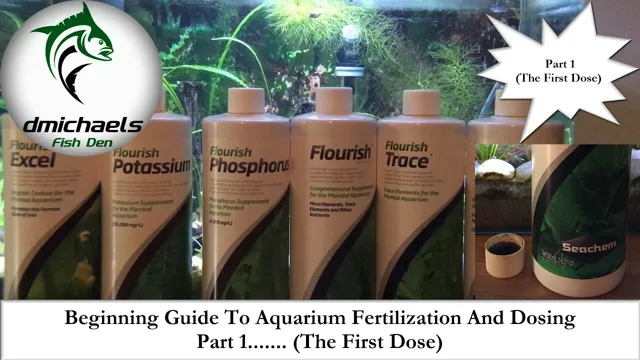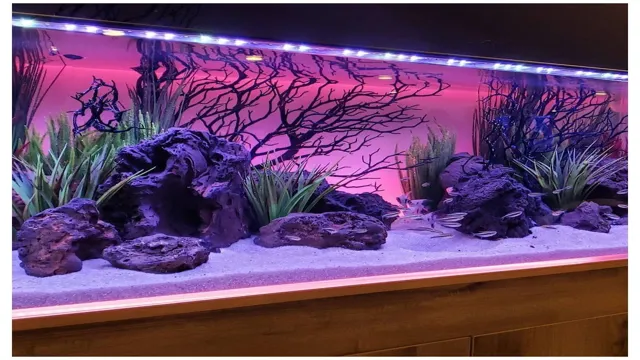Creating hills in a planted aquarium is an excellent way to add a touch of natural beauty and complexity to your underwater world. Not only do they add a unique visual appeal, but these hills can also serve as functional ecosystems for your aquatic plants and fish. With a little bit of creativity and some careful planning, anyone can create a stunning landscape that is both beautiful and beneficial for your aquatic pets.
One of the biggest challenges in designing an aquarium landscape is finding ways to add dimension without sacrificing the beauty of the plants and fish. When you add hills to your aquarium, you create a place for your plants to grow and thrive, while also giving your fish a place to explore and play. You can even use materials like stones, driftwood, and aquatic plants to create natural barriers and hiding spots for your pets.
But how exactly do you go about creating hills in a planted aquarium? The key is to start with a sturdy base and build upward from there. Depending on the size of your aquarium, you may be able to use a combination of sand, gravel, and rocks to create the base of your hill. From there, you can add layers of substrate and plants, gradually building up the height and shape of your hill.
Of course, it’s essential to keep in mind the needs of your plants and fish when designing your hills. Make sure that you choose plants that are well-suited to your aquarium’s conditions, and avoid overcrowding or overfeeding your fish. With some careful planning and a little bit of creativity, you can create a gorgeous and functional aquarium landscape that will be the envy of all your friends.
So why not give it a try and see what kind of beautiful underwater world you can create?
What You Need
If you’re looking to add some dimension and visual interest to your planted aquarium, creating hills can be a great way to achieve this effect. To begin, you’ll need a sturdy base layer, such as sand or gravel, for the hill to rest on. Next, you’ll want to gather materials to create the hill itself, such as rocks or driftwood.
These materials should be arranged in a way that slopes up gradually, eventually culminating in a peak. Once your hill is in place, you can begin planting your aquatic vegetation. To maintain the hill’s structure over time, it’s important to regularly prune and trim your plants.
With a bit of patience and upkeep, your planted aquarium can be transformed into a stunning and dynamic aquatic landscape, complete with stunning hills and valleys.
Aquarium Soil
If you’re looking to set up a healthy and thriving aquarium, choosing the right substrate is crucial. One popular option is aquarium soil, which is designed to mimic the natural environment of aquatic plants. But what exactly do you need to create a successful aquarium using aquarium soil? Firstly, it’s important to note that not all aquarium soils are created equal.
Look for brands that are specifically formulated for planted tanks, and avoid any that contain harmful chemicals or additives. In addition to aquarium soil, you’ll also need a good quality filter to keep the water clean and healthy, as well as appropriate lighting to support plant growth. Finally, a little bit of research into the specific needs of your chosen plants will help ensure that your aquarium flourishes.
Whether you’re a seasoned aquarium enthusiast or just starting out, aquarium soil can be a great option for creating a beautiful and healthy aquatic environment.

Rocks and Stones
If you’re looking to start a rock or stone collection, there are a few essential things you’ll need to get started. First and foremost, you’ll need a good rock identification guidebook. This will help you learn how to identify the different types of rocks and stones you come across and understand their unique characteristics.
Additionally, you may want to invest in some basic tools such as a rock hammer and chisel to help you extract rocks from their natural environment. A magnifying glass can also come in handy for examining the finer details of your specimens. Of course, you’ll also need a place to store your collection, such as a display case or grouping of shelves.
Finally, it’s important to have a sense of curiosity and an interest in the natural world to truly appreciate the beauty and diversity of rocks and stones. Whether you’re interested in the history and geology of these ancient relics or simply appreciate their aesthetic appeal, there’s no shortage of wonders to discover in the world of rocks and stones. (See Also: How to Make a Cuban Wall Aquarium in 7 Easy Steps: A Beginner’s Guide)
Plants
Plants are a great addition to any home or garden, but taking care of them can sometimes be challenging. To ensure that your plants thrive, there are a few things you need to keep in mind. Firstly, you need to make sure that your plants are getting enough light, as this is crucial for photosynthesis.
Different plants have different light requirements, so be sure to do your research and place your plants accordingly. Secondly, make sure you’re watering your plants properly. Overwatering can lead to root rot, while underwatering can cause your plants to dry out.
Again, different plants have different water requirements, so read up on your plants before watering. Finally, make sure you fertilize your plants regularly. This will provide them with the necessary nutrients to grow and remain healthy.
Remember, taking care of plants takes time and effort, but it’s worth it to see them flourish.
Steps to Create a Hill
Creating a hill in your planted aquarium can add depth and variety to the overall aesthetic. The first step is to choose the right materials for the job. You will need a substrate, such as sand or gravel, and rocks that are safe for aquariums.
Next, create a base layer of substrate and position your rocks to form the shape of the hill. Once you are satisfied with the shape, add another layer of substrate around the rocks to secure them in place. It’s important to ensure proper water flow throughout the hill, so be sure to leave gaps between the rocks for proper circulation.
Finally, add plants to the hill for a natural look. Select plants that can thrive in a hilly terrain, such as Java fern or Anubias. With patience and careful planning, you can create a stunning hill in your planted aquarium.
Step 1: Layout the Hill Shape
Creating a hill can seem like a daunting task, but with a few simple steps, you can make a beautiful addition to your landscaping. Step 1 is to layout the shape of the hill. This can be done with a shovel, preferably a square blade shovel.
Begin by marking the area where you want the hill to be. Once you have the general shape marked, insert the shovel into the ground at the edge of your marking and press down firmly. Pull the shovel toward you, creating a straight edge.
Continue this process, following the outline of the hill. Make sure to remove any grass or debris as you go. The finished shape should be a gentle slope with a rounded peak.
With step 1 completed, you are one step closer to creating a beautiful hill that will enhance the look of your property.
Step 2: Add Aquarium Soil
Adding aquarium soil is an essential step in creating a hill in your aquarium. The soil not only serves as a foundation but also provides nutrients to the plants growing on the hill. First, you need to decide on the type of soil that will be suitable for the plants you wish to grow.
You can choose from a variety of soil types such as clay, sand, or even gravel. Adding a good-quality aquatic soil mix will help in providing a rich source of vital nutrients to your plants. To create a hill, you need to pile up the soil in a slope-like manner, gradually increasing the height towards one end.
Make sure that the soil is distributed evenly to prevent any slippage of plants. Once you have placed the soil according to your desired shape, it’s time to add the plants. Place the plants in such a way that it looks natural and visually appealing. (See Also: How to Maintain Aquarium pH Level: Tips and Tricks to Keep Your Fish Happy and Healthy)
Adding aquarium soil is a crucial step in creating a hill that not only looks good but also provides a healthy and thriving environment for your aquatic plants.
Step 3: Add Rocks and Stones
Adding rocks and stones is the final step in creating a hill. These natural elements not only add aesthetic appeal but also provide stability to the hill. It is important to use a variety of sizes and shapes to create a more natural look.
Large rocks can be used to form the base and anchor the hill while smaller stones can be placed around them to fill in gaps. Be sure to bury the rocks and stones partially in the soil to provide stability and prevent them from shifting. The type of rocks and stones used can also vary depending on the look you are trying to achieve.
Adding colorful rocks or stones with unique patterns can add a pop of color to the hill. With this final step, your hill will look like a natural and stunning feature in your landscape.
Step 4: Plant the Hill with Suitable Plants
Now you’re ready for the fun part of creating a beautiful hill – choosing and planting suitable plants! Selecting the right plants for your hill is essential for maintaining the health of the soil, preventing erosion, and adding color and texture to your landscape design. Start by considering the conditions of your hill – is it sunny or shady, is it dry or moist? Select plants that are appropriate for the location and also complement the type of soil in your area. Consider using a variety of plants, such as evergreens, shrubs, perennials, and grasses, to create interest and diversity in your hillside garden.
Don’t forget to incorporate plants with different blooming seasons to ensure beautiful blooms throughout the year! With the right selection and placement of plants, your hill will become a stunning masterpiece that adds value to your property.
Maintaining Your Hill
Creating hills in your planted aquarium can add a unique and dynamic element to your aquarium’s design. However, maintaining those hills can be tricky. To start, you’ll want to make sure the substrate you use for your hill is substantial, such as sand or gravel, and that it’s deep enough to properly support your plants.
When setting up your hill, make sure to create a gradual slope to prevent plant roots from being exposed. After planting, cover the hill with a thin layer of sand to prevent soil from washing away. It’s also important to regularly check and adjust the placement of plants on the hill to ensure they’re receiving enough light and nutrients.
With these tips, you’ll be able to create and maintain a stunning hill in your planted aquarium.
Regular Pruning
Regular pruning is a crucial factor in maintaining the health and beauty of your hill. Pruning entails the removal of dead or diseased branches from the trees. It’s essential to do it routinely to prevent the trees from becoming overgrown and weak, which can result in them falling and causing harm.
Additionally, regular pruning promotes the growth of new and stronger branches without affecting the overall beauty of the hill. The process involves taking out branches, twigs, and even roots that are no longer serving the tree’s purpose. It can be a time-consuming task, but it’s well worth the effort.
Pruning keeps your hill looking its best and ensures the safety of the surrounding area. So make sure to schedule regular pruning sessions to keep your hill healthy, vibrant, and stunning for years to come.
Fertilize the Plants
Fertilizing your plants is a crucial part of maintaining your hill. It’s important to ensure that your plants are getting the proper nutrients they need to grow strong and healthy. When choosing a fertilizer, it’s essential to understand the different ratios of nitrogen, phosphorus, and potassium, as well as the pH level of your soil. (See Also: How to Build an Aquarium RS34: Tips and Tricks for a Successful Setup)
Nitrogen promotes leaf growth, phosphorus aids in root and flower development, and potassium helps with overall plant health and disease resistance. By using a fertilizer with the correct balance of these nutrients, you can keep your plants healthy and thriving. Remember to apply fertilizer evenly and to water thoroughly afterward to ensure that it reaches the roots.
Proper fertilization will not only keep your hill looking beautiful, but it will also help you get the most out of your plants.
Conclusion
In conclusion, making hills in a planted aquarium is all about layering and creativity. With the right materials and a little bit of effort, you can create a stunning landscape that not only adds dimension but also provides a naturalistic habitat for your aquatic friends. Just be careful not to overdo it, or you might end up with the aquatic equivalent of Mount Everest! Remember, less is often more when it comes to creating a beautiful aquatic environment, so get creative and let your imagination run wild! Happy aquascaping!”
FAQs
What materials do I need to make hills in a planted aquarium?
To make hills in a planted aquarium, you will need aquarium-safe rocks, substrate, and plants.
How do I create contours on the hills in a planted aquarium?
You can create contours on the hills by layering the substrate on the hills, and then molding the hills to the desired shape using your hands or a molding tool.
What type of plants should I use on the hills in a planted aquarium?
You can use a variety of plants on the hills in a planted aquarium, such as carpeting plants, moss, or stem plants.
How do I prevent the hills from collapsing in a planted aquarium?
To prevent the hills from collapsing, make sure to use strong rocks and create a solid foundation by layering the rocks and substrate.
Can I add fish to the aquarium right after creating the hills?
It is best to wait at least one week after creating the hills before adding fish to the aquarium to allow the plants to settle and establish roots properly.
How do I maintain the hills in a planted aquarium?
Maintain the hills by regularly trimming and pruning the plants, and removing any dead or decaying matter from the substrate.
Are there any specific lighting requirements for the plants on the hills in a planted aquarium?
Different plants may have different lighting requirements, so it is important to choose plants that are suitable for the lighting conditions in your aquarium and provide adequate light for the plants to grow.

